Since Zagreb is located in the northern center of the country and quite far from the coast, the city is not only geographically off the tourist tracks. Many visitors simply skip the city and head straight to Croatia’s gorgeous shores and islands. Yet, it is precisely the opportunity to experience real Croatian city life that makes a visit to Zagreb, Croatia’s capital, so interesting – in contrast and as a cultural complement to the beautiful places alongside the Istrian and Dalmatian coast.
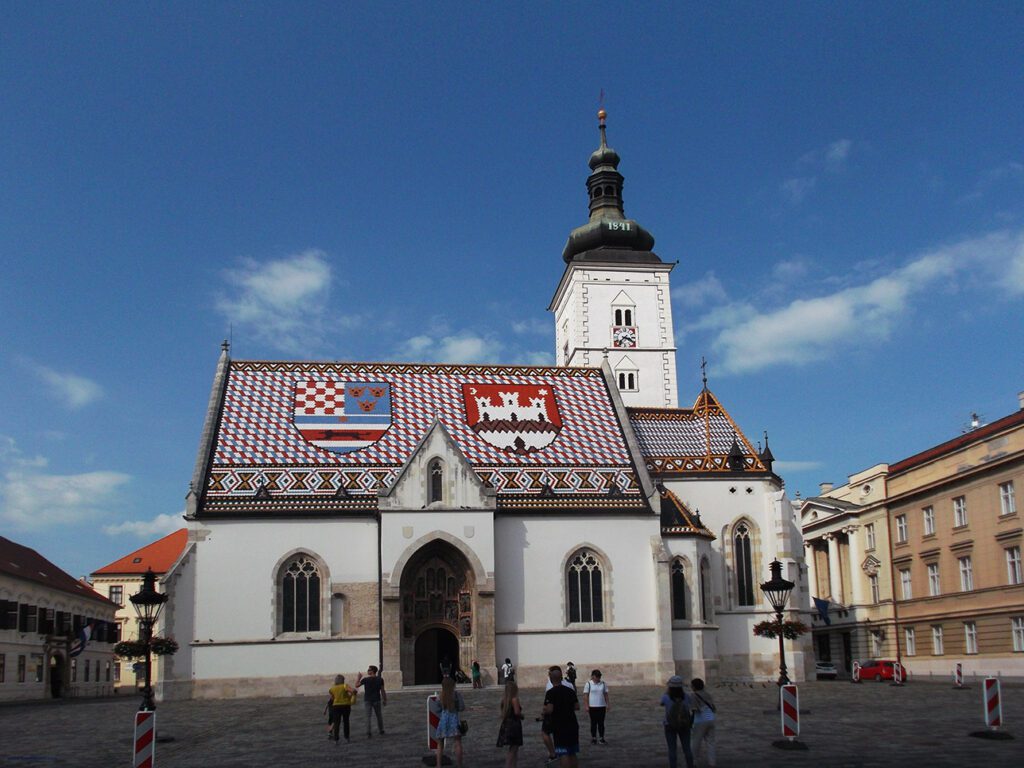
Back in Time
I’m on a beach, it’s late at night, it’s pitch dark, there is a weak campfire and someone is playing guitar.
I can see this scene before me like looking through a veil. And I see it in black and white. Maybe because it’s so dark that the eye cannot distinguish colors but everything appears in shades of softening grey. Or maybe it’s because this scene is so old that there are only pictures in black and white left from that time.
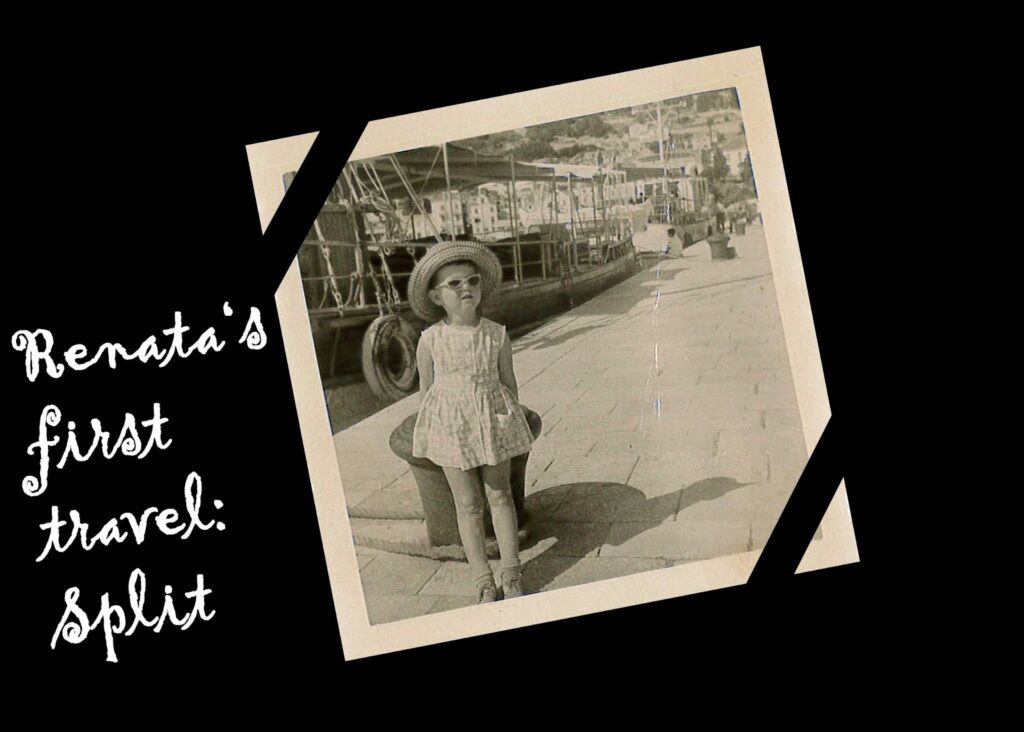
It must have been in the mid-60s. We were living in Czechoslovakia. Socialist Czechoslovakia. Obviously, behind the proverbial iron curtain, travelling was very limited. I had just outgrown the toddler age. My mother and I had gone by train from Prague to what at that time was called Yugoslavia. General Tito’s Yugoslavia. A socialist country, but open to the West. Mentally, metaphorically, and literally. Here, the reliable communist who would not take advantage of open borders was able to spend his vacation side by side with vacationers from the West who enjoyed Yugoslavia’s cultural and natural beauty at a pretty cheap price. In return, they were ready to lower their sights when it came to supply and service.
However, later, my mother always claimed that I had had some sickness that had to be cured under the Yugoslavian sun, which I think was a legend to make things more interesting. I don’t remember having been sick. All I remember is this black-and-white moment late at night on a beach. I must have been two or three years old.
Back to Yugoslavia
Many decades later, I came back to Yugoslavia. To a country that doesn’t exist anymore.
After Tito died in 1980, things got out of hand. In 1991, a very complex political firestorm started and finally became one of the cruelest wars of the 20th century. Old rivalries, vengeance for collaborating with the Nazis in WWII, ethnic and religious conflicts – all hell broke loose.
Today, about twenty years later, they finally are autonomous countries, and Croatia, stretching along the Adriatic coast, became a vacationers’ paradise very soon.
In Zagreb, all these atrocious pictures from the 90s began haunting me. They were triggered by a picture at the Muzej suvremene umjetnosti, the Museum of Contemporary Art.
There, a composite photograph hit me right in the gut.
I couldn’t get the girl’s eyes and mainly the inhuman words of the graffiti out of my head. The worst thing is, they had been written by one of the Dutch UN soldiers, a soldier who was sent there to protect the Bosniaks, the ethnic group his writing was more than mocking. Somehow it symbolizes the big failure of that Blue Helmet Mission.

Not Forgotten, Not Forgiven
Later that day, I was a bit shocked when the tour guide asked whether we had heard of the war in Yugoslavia. I mean, I was surprised when a guide in Vietnam asked the same thing – but however, that military conflict had started in the 1950s. I do remember the news, but I was a child then. Those who have survived as adults are at least in their 70s.
But the Srebrenica massacre was like…yesterday. At that time, I had a child myself.
The pictures from those camps, the mass rapes, the ethnic cleansing.
I feel like when I was in Cambodia: I’m searching for traces, I’m looking at places and think This is where it happened; right here, where I am vacationing now.
I’m looking into faces, wondering What did you do? What did you have to endure?
How do these peoples live on with that burden? According to Kristina, my Zagreb guide, there isn’t a museum, there is no reappraisal.
I’m sad. And a bit depressed. It makes me sad that only twenty years after such a tragedy, a group of people is asked – probably for a reason – whether they have heard about one of the most gruesome military conflicts of the last century.
I’d like to know: How do you deal with other countries’ past and history? Does it affect you in your travelling? I’m really curious and would appreciate your comment in the section below.
Visiting Zagreb
Zagreb is home to more than 800,000 people, thus Croatia’s largest city and the country’s capital. However, I assume that tourism-wise it’s also the least known and visited place in all of Croatia.
However, it was a pleasant and inspiring start to my bus road trip along the Adriatic coast.
I must admit, it started with a shock. Arriving at the bus station, I got some Croatian money at an ATM, and bought a ticket to Poreč for the next day – which I had to pay in cash. Then I looked for my apartman located about ten minutes away.
After checking in, I took off to the Museum of Contemporary Art. I had read that this is one of the must-see things in otherwise rather dull Zagreb.
On tram #6, I realized how little touristy Zagreb is: Obviously, I had some questions regarding my final destination and the ticket I needed – and nobody seemed to speak just one word English. There was a survey regarding language skills on the tram and they actually found a guy – crazy little world: an English teacher. Faith was kind.
So that was a little bit unsettling – I don’t want to brag here, but I’m simply not used to not being able to communicate.
Zagreb’s Concrete Jungle
What I then saw on my way to the gallery shocked me: Kilometers and kilometers of brutal concrete buildings of the worst socialist architecture you can imagine. Figure riding on a train for half an hour through project buildings – nothing but project buildings. In different heights and various widths – but all of them like concrete bunkers. Surreal. Not the pretty kind of surreal.
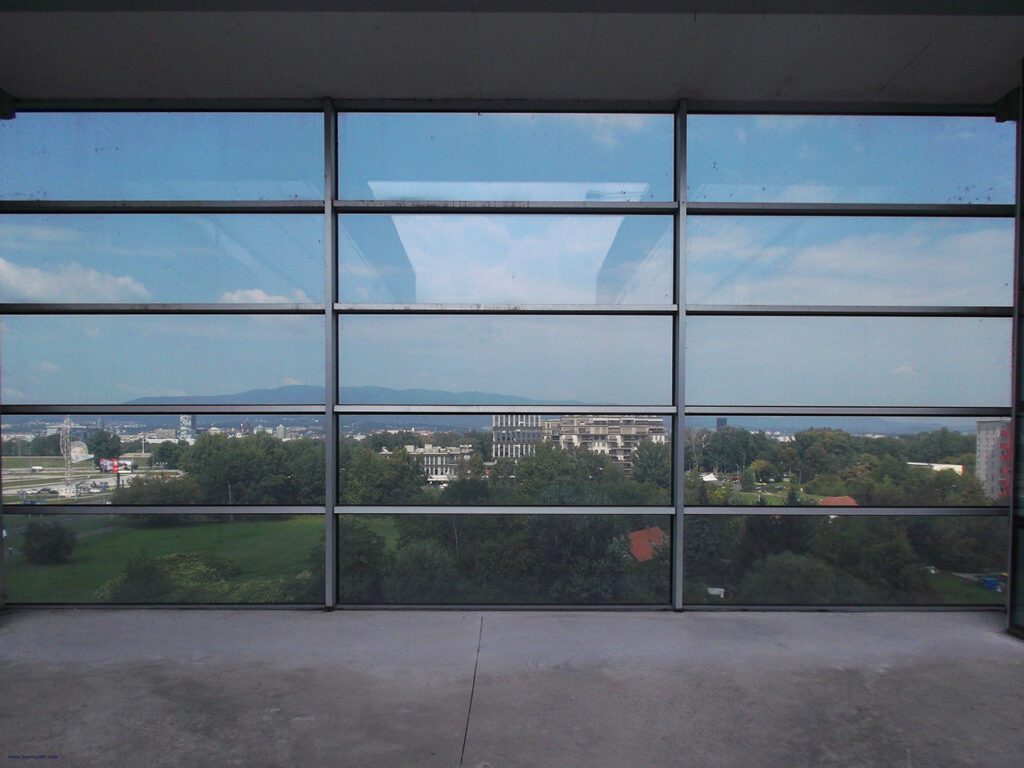
The venue is….okay. You don’t miss out on much when you don’t go there – unless you’re crazy ’bout concrete – then the ride there and back is your big chance.
Many of the exhibits are rather depressing – which matched quite well with the architecture outside.
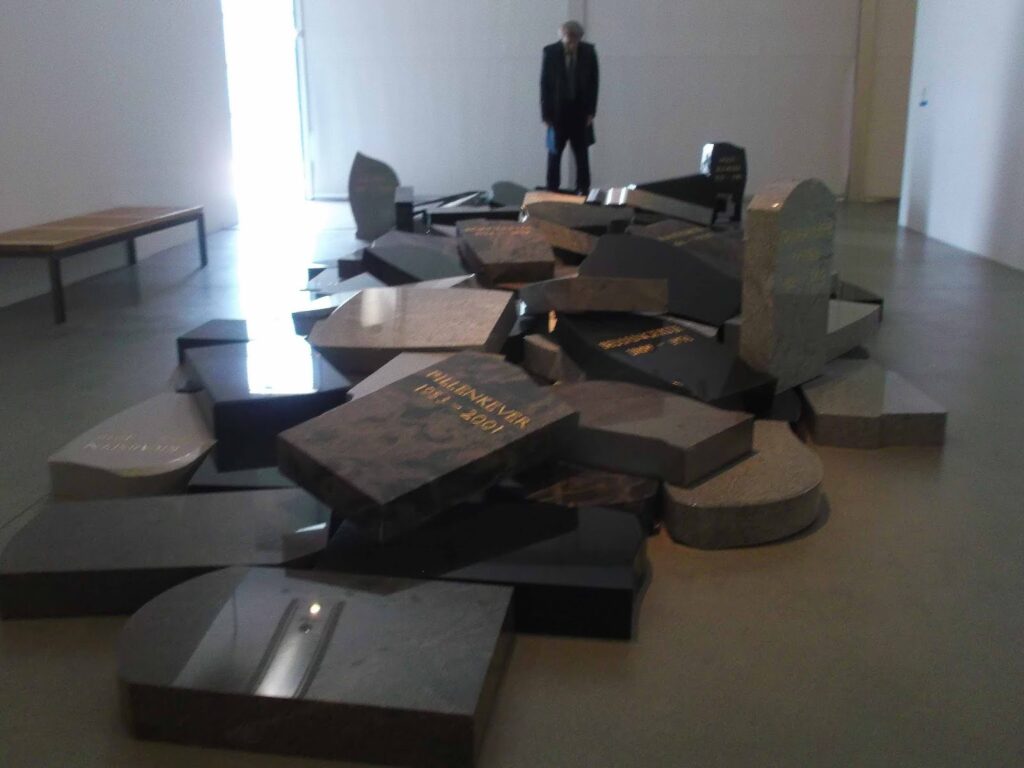
After taking the tram for another half an hour across the concrete hell, I got off at the train station – and this is where my guide begins. Because unless you are driving, you will always arrive either at the bus station or the train station – even coming from the airport.
The City Center
Zagreb has a U-shaped green belt in the city center which makes walking very pleasant. Across the street from the train station, Croatia’s first King, Tomislav, welcomes the visitors – and then you just keep on walking through the parks to the city center.
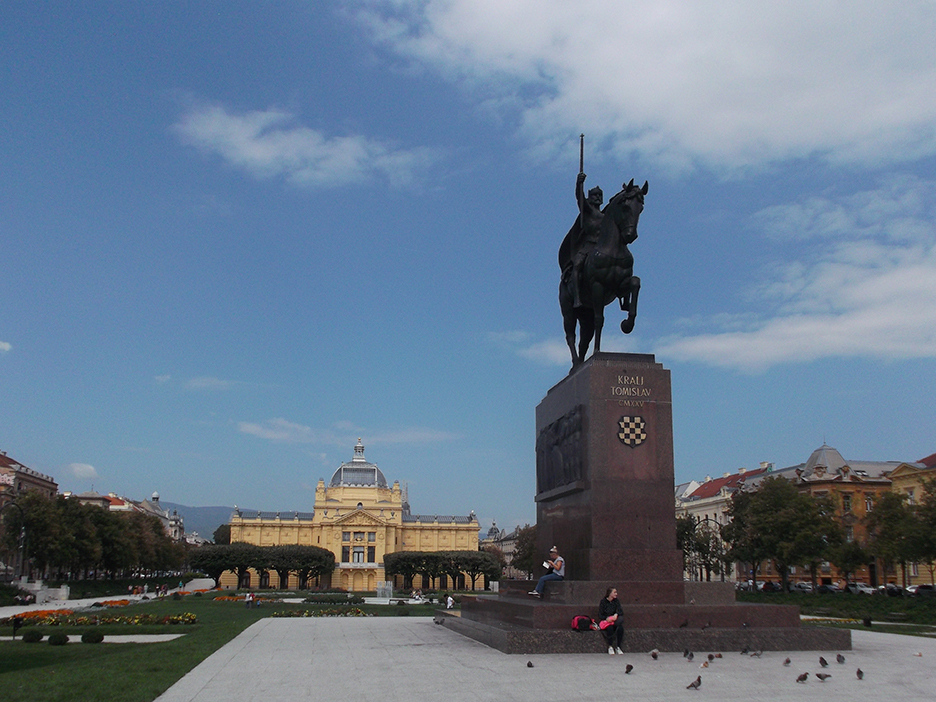
Art And Academy
You’ll see the Umjetnički paviljon, the Art Pavilion housed in a beautiful yellow building from the 19th century.
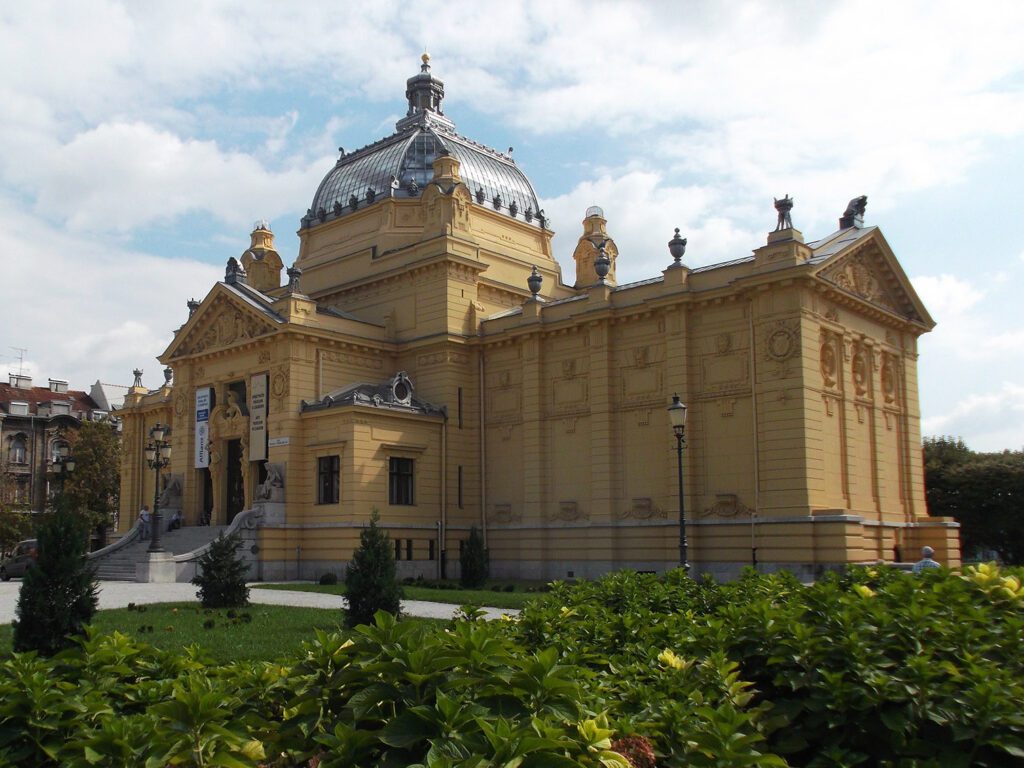
Since they operate as a gallery, i.e. there is no permanent collection, please check what is on if you’d like to visit
Art Pavilion
Umjetnički paviljon u Zagrebu
Trg kralja Tomislava 22
10000 Zagreb
Phone: + 385 – 1 – 4841 070
During exhibitions, the pavilion is open Tuesday to Sunday from 11 a. m. to 8 p. m. (Friday till 9 p. m.)
Next is the Library of the Croatian Academy of Arts and Sciences and on the same lot also the Croatian Academy of Sciences and Arts with a statue of Josip Juraj Strossmayer, a cleric and politician from the 19th century.
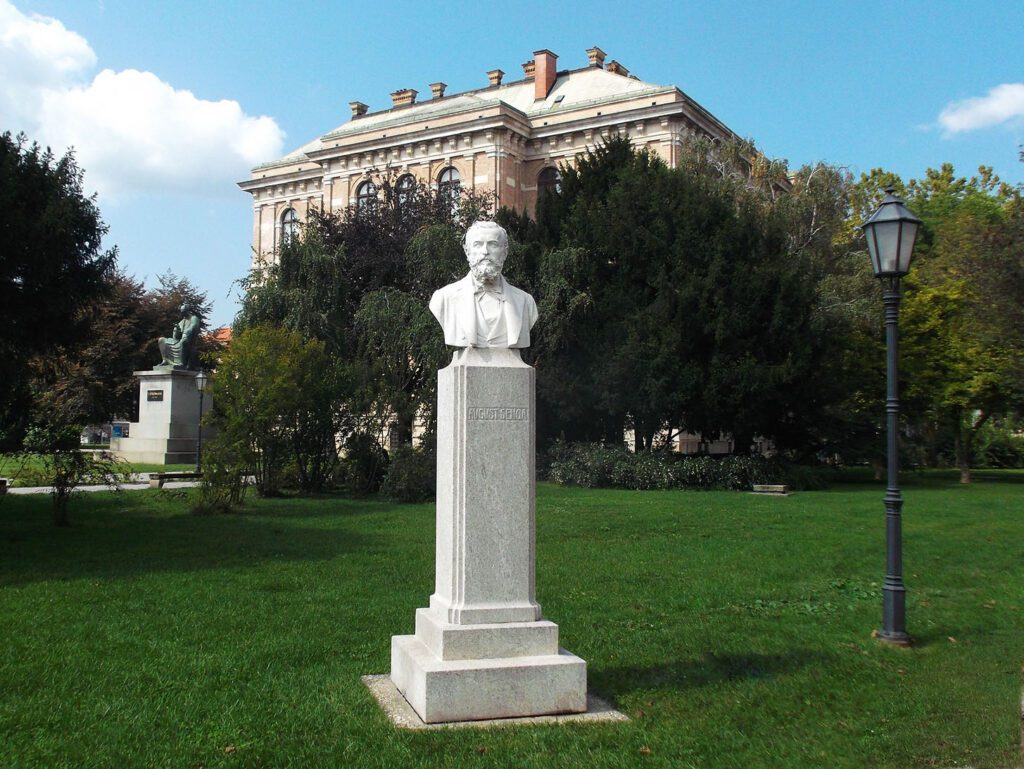
Majestic Hotel And Bourgeois Art
Before you continue your walk towards the center, it’s totally worth it to check out the buildings on the other side of the J. J. Strossmayera street – like the Palace Hotel Zagreb, located in a majestic Art Nouveau Palace – here Croatia is showing more of the Austro-Hungarian than the Italian influence.
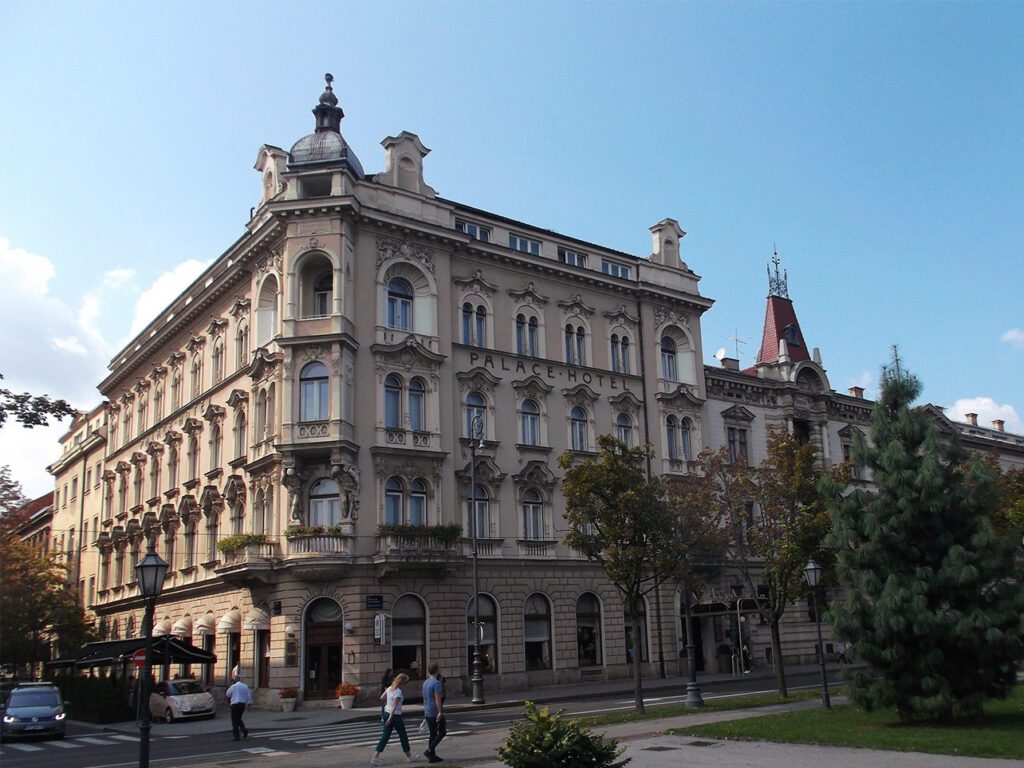
Even if you’re not a guest, you can enjoy a break in a splendid atmosphere full of old-world charm.
Palace Hotel Zagreb
Trg J.J. Strossmayera 10
10 000 Zagreb
Phone: + 385 – 1 – 4899 600
Email: palace@palace.hr
At the next corner, a great art museum is awaiting visitors: The Modern Gallery introduces Croatian artists from the 19th to 21st centuries.
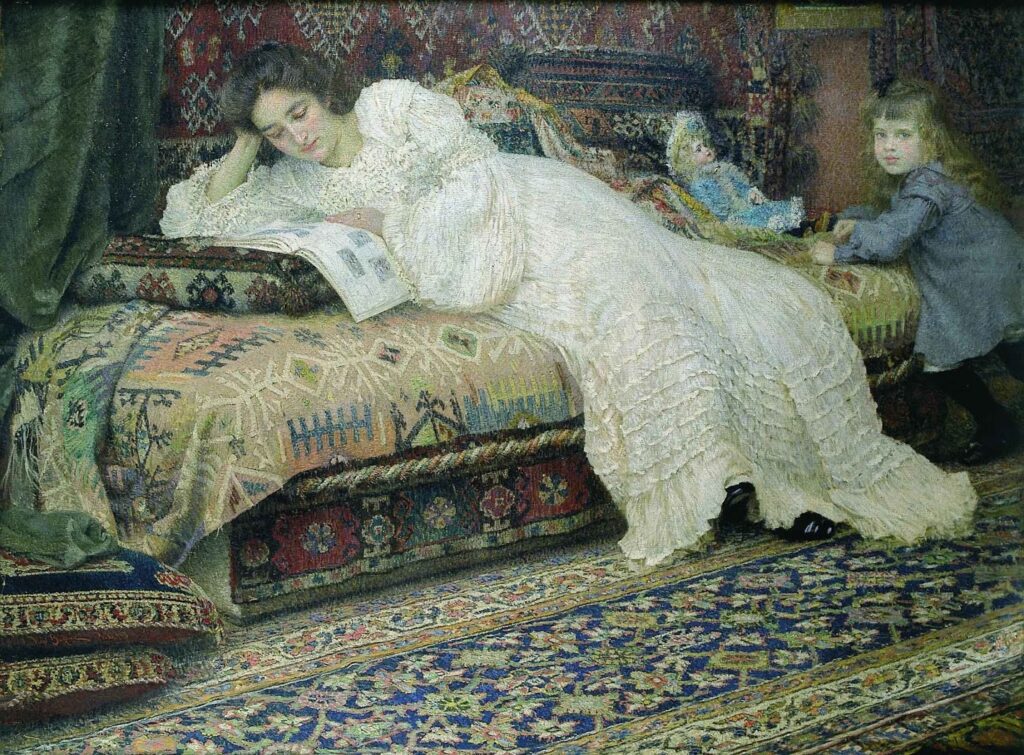
(Photo: Vlaho Bukovac creator QS:P170,Q468219, Vlaho Bukovac – Divan, public domain, details on Wikimedia Commons)
Modern Gallery
Andrije Hebranga 1
Zagreb
Phone: + 385 – 1 – 60 410 40
Email: moderna-galerija@zg.t-com.hr
The Gallery is open from Tuesday to Sunday 11 a. m. – 7 p. m. (Saturday and Sunday to 2 p. m.)
A Green Belt
Back to the green belt, adjacent to the Strossmayer park is the Park Zrinjevac which you should not miss for the collection of busts of famous Croatian people. To be honest, I didn’t know any of these good men, but the artwork is beautiful just the same.

On the west side of the park is the Archeological Museum of Zagreb where many epochs of the country’s ever-changing history are covered.
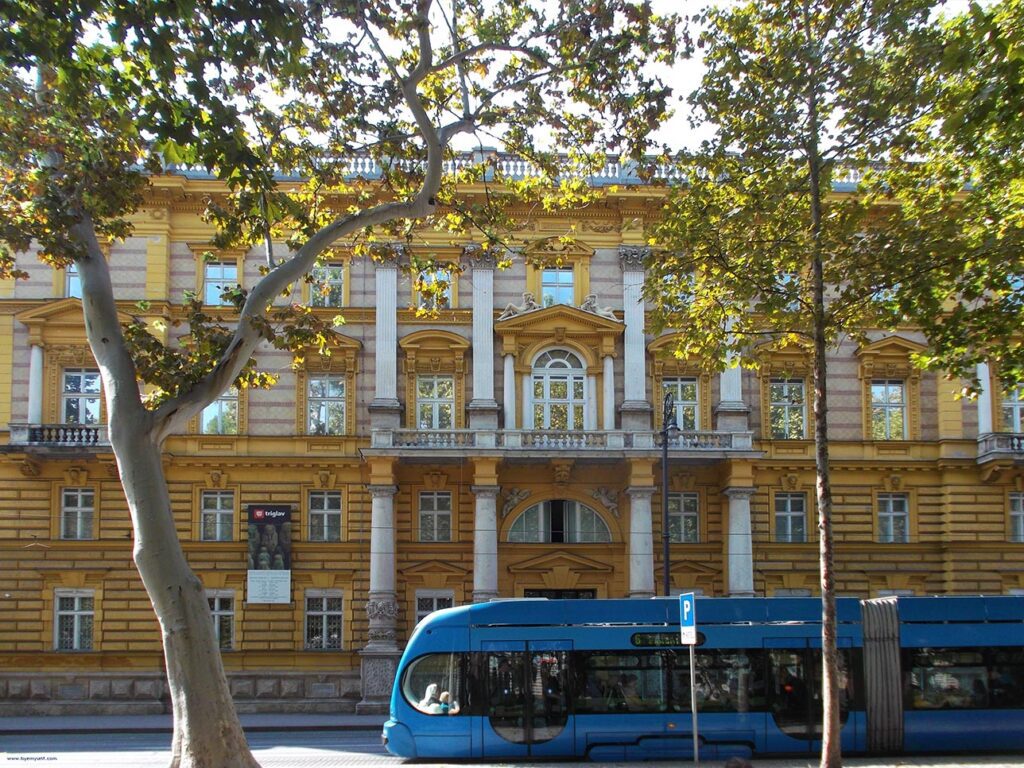
Archaeological Museum in Zagreb
Trg Nikole Šubića Zrinskog 19
10000 Zagreb
Phone: + 385 – 1 – 4873 101
The Museum is open from Monday to Saturday from noon to 6 p. m. (Saturday to 3 p. m.)
The Cradle of Zagreb
One more block up the road and you reach the Trg Bana Josipa Jelačića which is Zagreb’s main square.
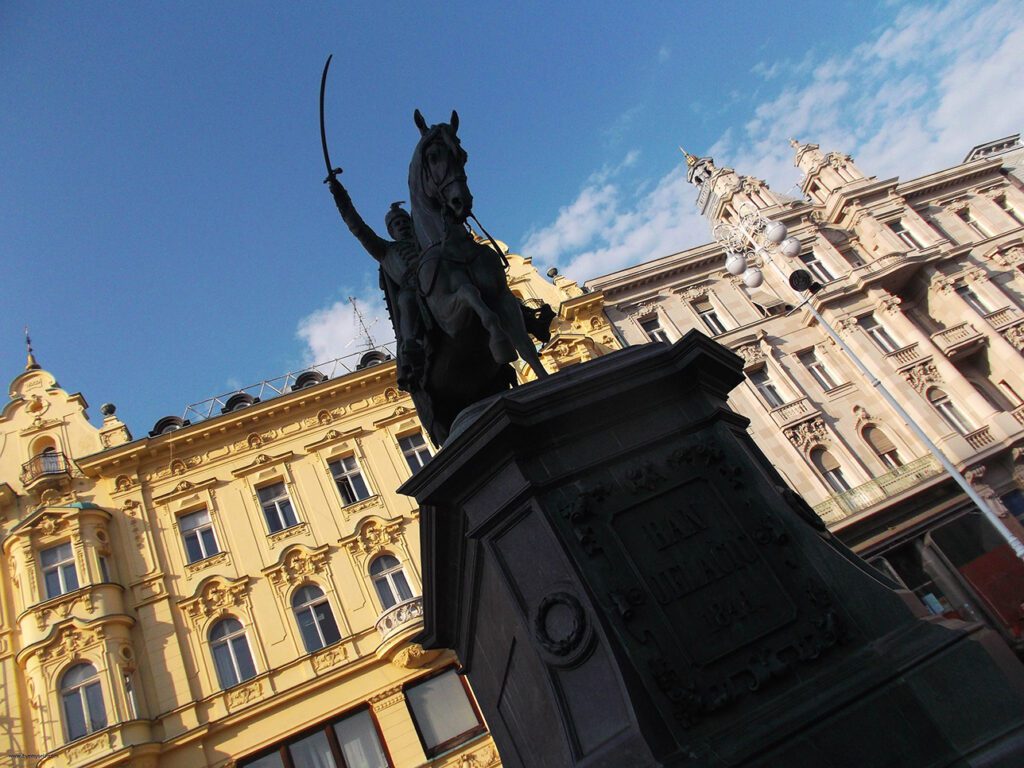
This square is not only the center of all the shopping you can do, here you also find the tourist office where you can get information, a free map – and a Zagreb-Card for 13 €uros for 24 respectively for 18 €uros for 72 hours there.
At least if the weather is not that great and you use public transport more and visit some of the museums, it’s worth the price. On a sunny day, I’m not really sure.
Free Walking Tour
A great way to get more insight is to join one – or more – of the tours organized by Free Spirit Tours, a project by Wayoudo d.o.o. travel agency. They offer a free walking tour – of course, based on tips – and a range of themed tours. Even if you explore the city on your own, joining one of these tours adds some great background info from a local.
One little tip: On the square is also a small market taking place and if you have the impression that this is a bit of a tourist rip-off, it only shows that you haven’t been to other places in Croatia. Take it from me, the closer you get to the coast, the more you pay for….literally everything. So if you have room in your luggage, stock up on souvenirs in Zagreb. I didn’t and I still regret it.
Whether you actually join the walking tour or if you explore the historic center by yourself, there are two central areas.
Uphill
To get to Zagreb’s upper town walk the main shopping street Ilica westwards and turn right into Tomiceva ulica. Here you can catch the funicular that takes you uphill in only four minutes. Actually, it is said to be the world’s shortest funicular ride and since it’s part of the public transportation system, it’s included in the Zagreb Card.
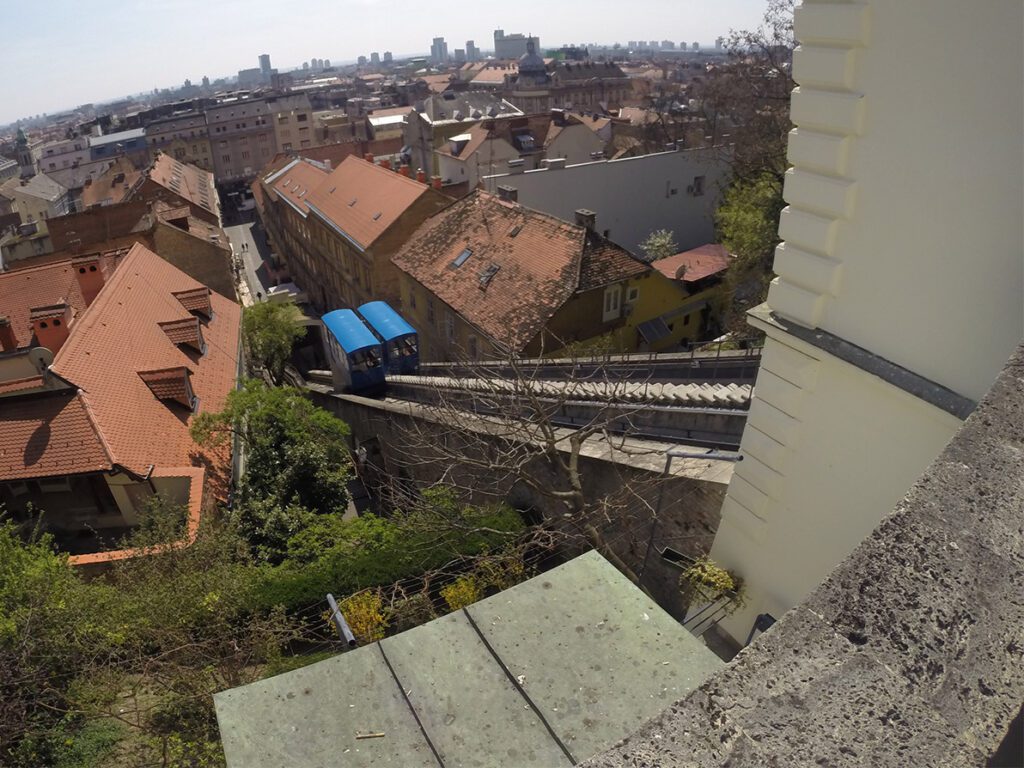
(Photo: Zrce.eu Tours UG, Standseilbahn Zagreb,cropped to 4:3, CC BY-SA 3.0 DE)
But I have to warn you: If you choose to ride over walking, you’ll miss one of Zagreb’s most charming little alleys Zakmardijeve Stube where street artist Boris Bare rolled out a red carpet for you. Walk it, work it, and then climb the stairs to the upper part of town.
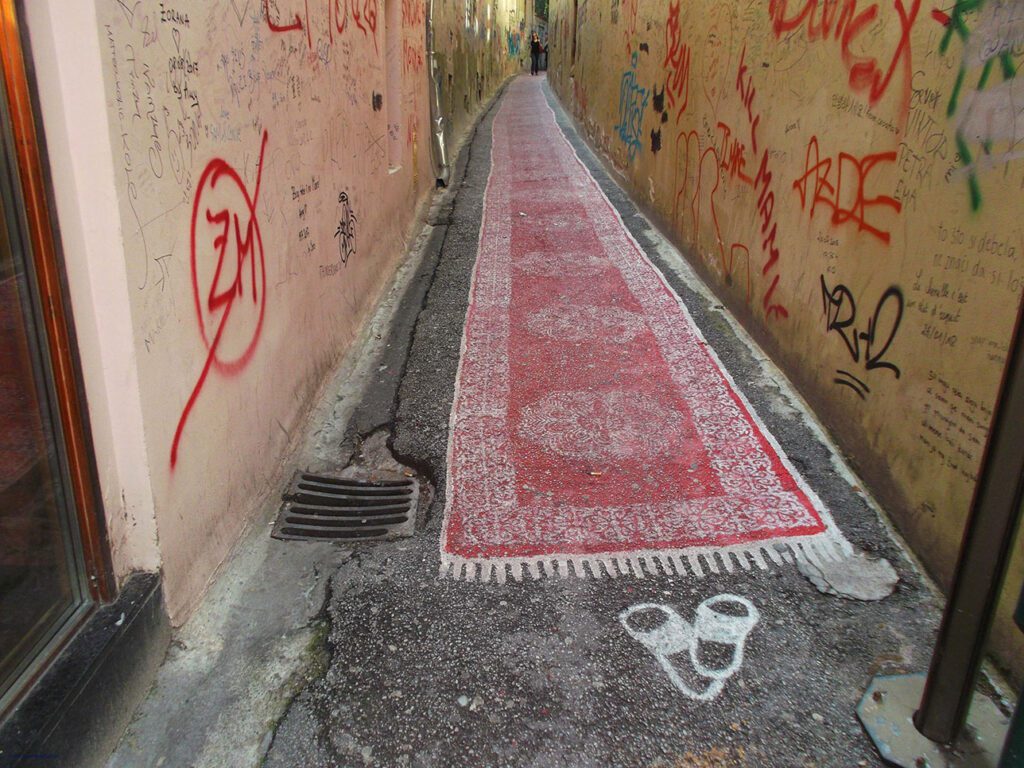
Walk the Zakmardijeve Stube all the way to the Lotrščak Tower, from where you’ve hopefully heard the cannon shot at noon.
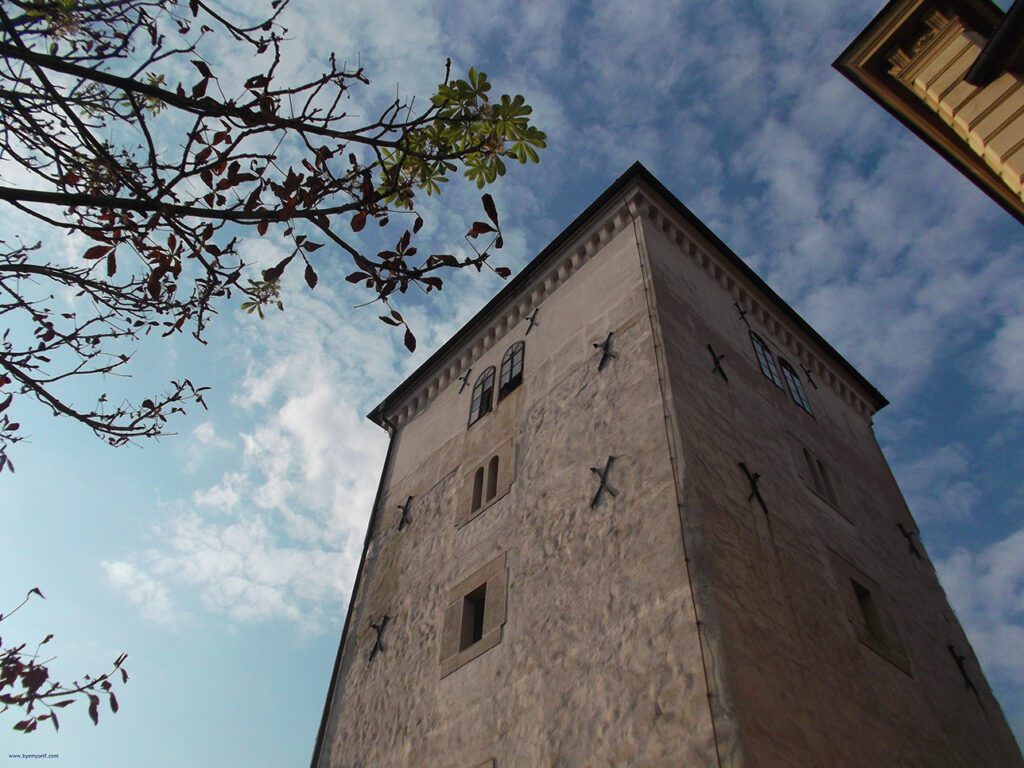
Yes, that’s right: At noon, there is a cannon shot from the Lotrščak Tower, announcing the mid-day in Zagreb. It is fired daily by a local cannon man – the fellow’s only job.
It’s said that this tradition derives from the time when it scared away the Ottoman troops. I find it a very charming quirk that they kept this tradition.
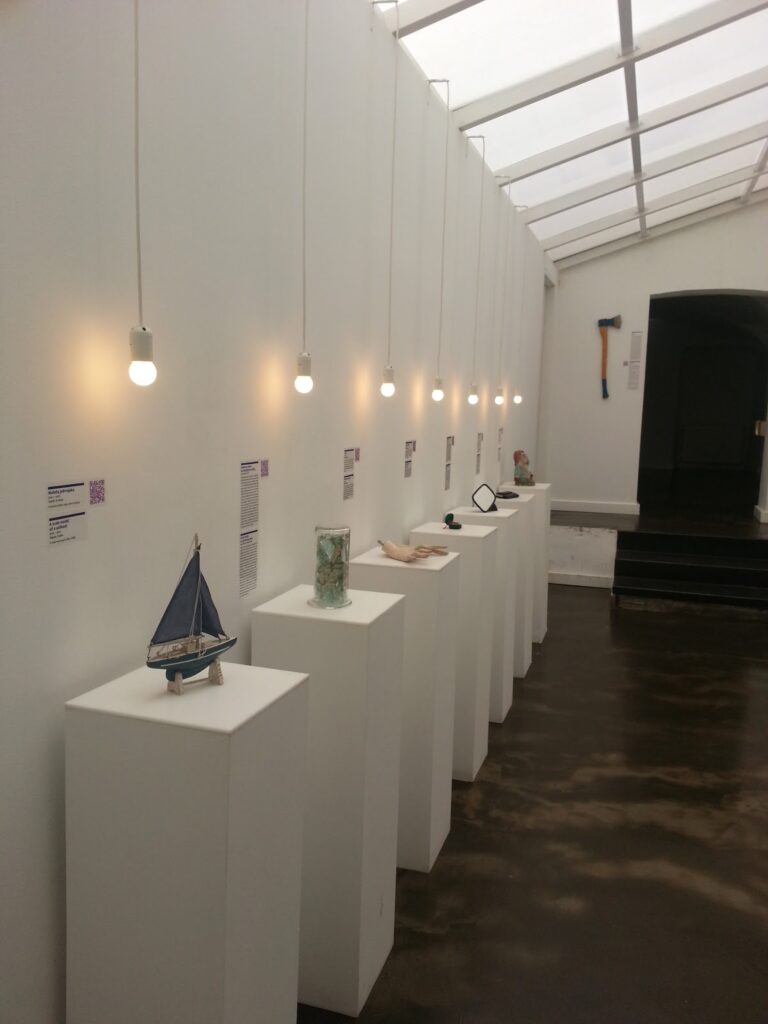
(Photo: Prosopee, Zagreb’s Museum of Broken Relationships second room, CC BY-SA 3.0)
So you get off at the Lotrščak Tower which – unless the cannon is booming – is pretty unspectacular – but across the street is another quirky attraction, the Museum of Broken Relationships.
Museum of Broken Relationships
Following the breakup of their own relationship, artists Olinka Vištica and Dražen Grubišić initiated this collection. Today, it consists of all kinds of pieces and tokens from…broken relationships; all kinds of relationships, not only between men and women but also between friends and family members.
While Vištica and Grubišić started the exhibition with their personal items, over the years, many people from all over the world donated their special pieces. They vary from hilarious to extremely disturbing.
After the exhibition, which started out in a container, toured different countries, since 2010, this award-winning collection is housed in Zagreb.
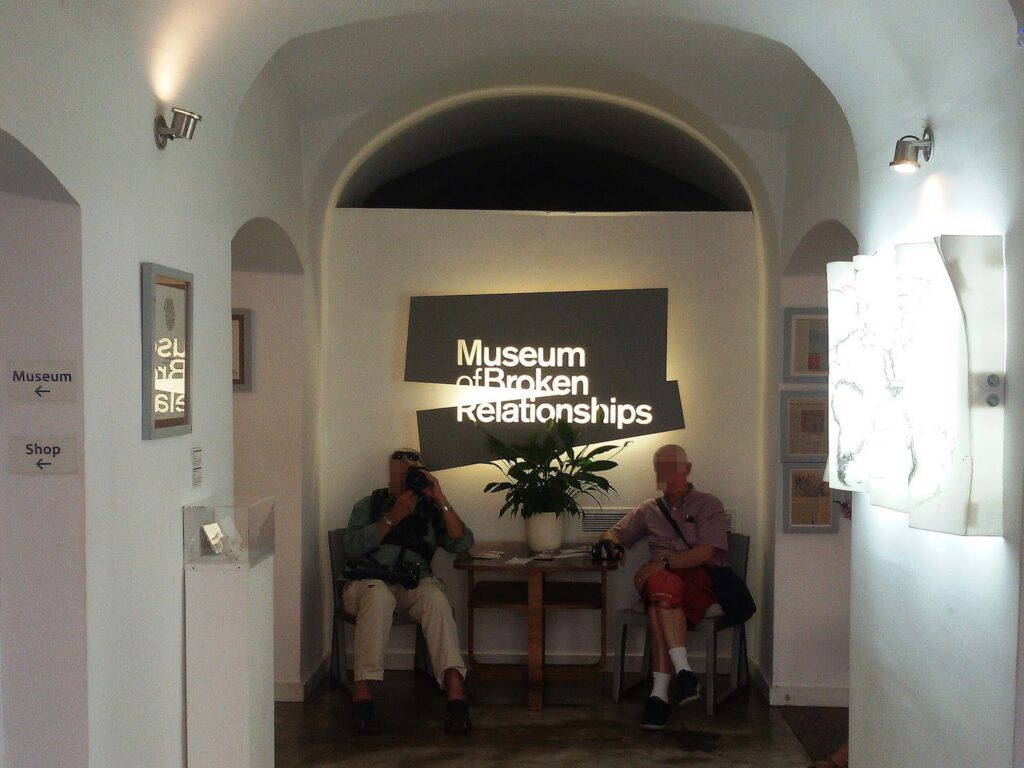
My tip: They have a gift shop with very cool, of course, topic-related, gimmicks and souvenirs.
Museum of Broken Relationships
Ćirilometodska 2
10000, Zagreb
Phone: + 385 – 1 – 4851 021
Email: info@brokenships.com
Opening hours: Daily from 9 a. m. to 9 p. m., from June to September to 10.30 p. m.
Croatian Museum of Naïve Art
Only one block up on the other side of the street is another museum worth visiting, the Croatian Museum of Naïve Art. Naïve Art, often showing rural scenarios, has a long tradition in Croatia and, without a doubt, this museum shows some real masterpieces.
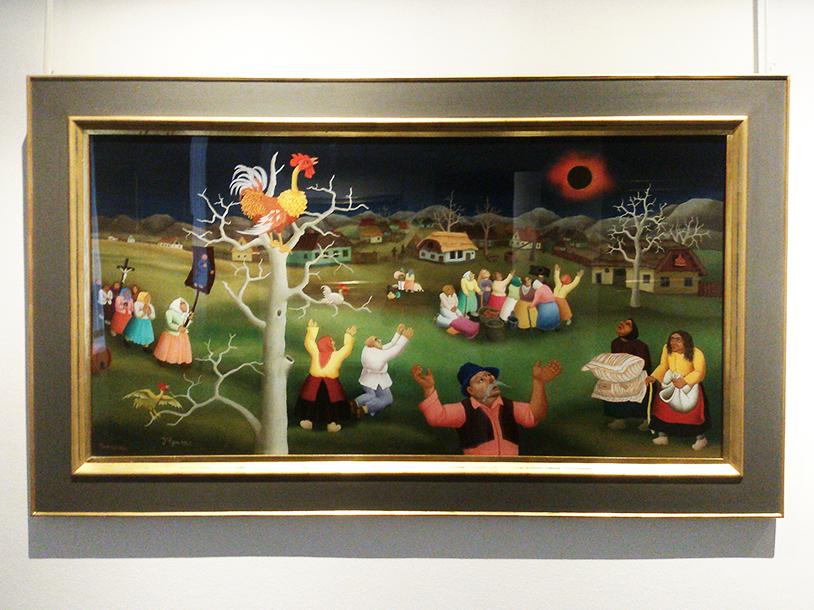
Here, too, you can get some unusual souvenirs like e. g. prints of the paintings on exhibition.
Croatian Museum of Naïve Art
Ćirilometodska ul. 3,
10000 Zagreb
Phone: + 385 – 1 – 4851 911
Email: info@hmnu.hr
Opening hours: Daily from 10 a. m. to 6 p. m., Sundays to 1 p. m.
St. Mark’s Church
One block further up you’ll finally get to the most iconic building of Zagreb, St. Mark’s church – a house of worship under an unusually colorful roof: The tiles are laid in a pattern representing the coat of arms of Zagreb as well as the Triune Kingdom of Croatia, Slavonia, and Dalmatia.

Probably built in the early 13th century, from 1866 to 1882, the church underwent a major reconstruction and this was also when the flashy roof was added.
It is certainly worth it to stroll a bit around this neighborhood and pay attention to the wonderful architecture mainly from the 18th century.
Stop for a moment at the Katarinin Trg, obviously, named after the Saint Catherine of Alexandria Church which was built in the 16th century and is known for its opulent baroque interior.

To the right is Gornjogradska Gimnazija Zagreb, the Upper Town High School of Zagreb, founded by the Jesuits in 1607 as the city’s first high school.
Panoramic Views
As you walk between these two buildings, you get to the panoramic viewpoint of Zagreb – from where you access the old town over a couple of stair flights.
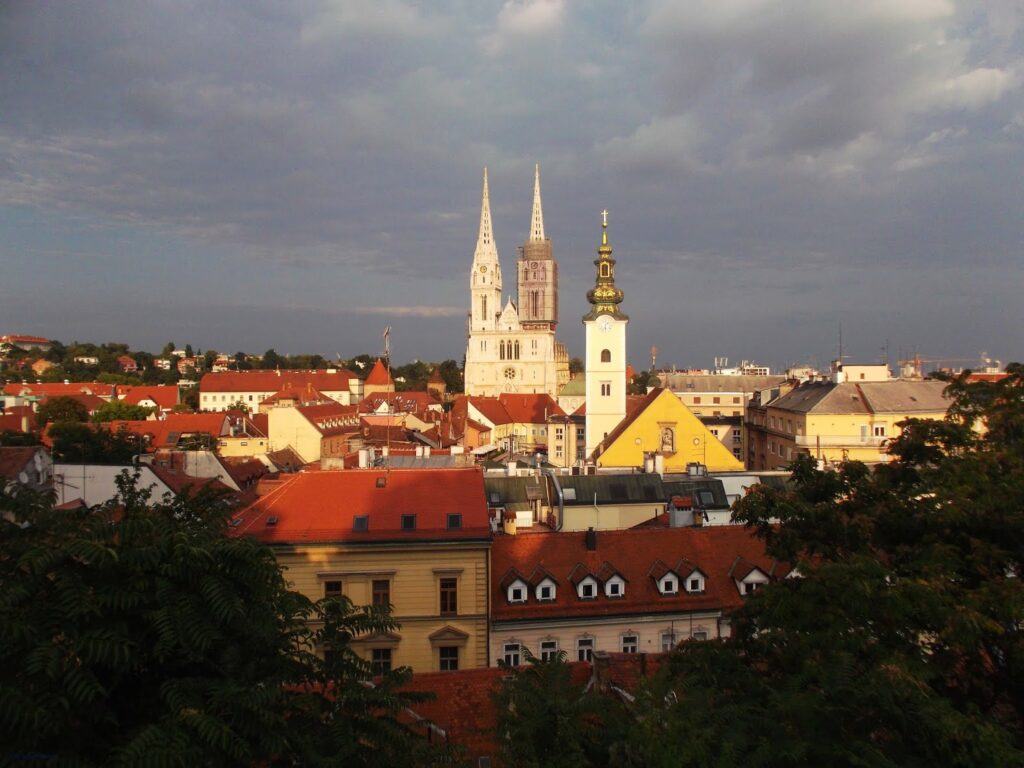
If you’ve missed Bare’s carpet, now’s the chance to take a close look at this unique piece of street art.
Now that you’re back on Radićeva ulica, you’re in the liveliest part of Zagreb; come back at night for a couple of drinks and friendly company. But for now, walk up to the little street called Krvavi Most, the bloody bridge, named after the former bridge over the Medveščak creek, which gained its disturbing name from the fights between the citizens of the two parts of Zagreb.
Today, you can peacefully cross to ulica Ivana Tkalčića, another hip and trendy neighborhood with lots of bars and restaurants.
Downtown
Dolac
From here, it’s just a very short walk to the Dolac, the market square. Every day from 7 a. m. to 2 p. m., you can join the Zagrebians grocery shopping at the farmers market. Also, some of the most popular restaurants can be found around this square.
From here, it’s just a stone’s throw to Zagreb’s imposing cathedral. It is not only the tallest building in all of Croatia but also higher than Notre Dame. Finished in 1217 – which was also earlier than Notre Dame – it is dedicated to the Assumption of Mary; and also to kings Saint Stephen and Saint Ladislaus.
The Cathedral can be visited daily from 10 a. m. to 5 p. m. ( Sundays only from 1 p. m.)
National Theater
This is the tour I would recommend. If you can squeeze it in, you should definitely pay the National Theater a visit. It’s said to be Zagreb’s most beautiful structure, built at the turn of the 19th century by Viennese architects Ferdinand Fellner and Hermann Helmer, hence it deems a bit like the miniature version of the opera house in Vienna.
Obviously, the plays are in Croatian, but there are also ballets and operas, so it’s possible to enjoy its splendor even if you are not familiar with the language.
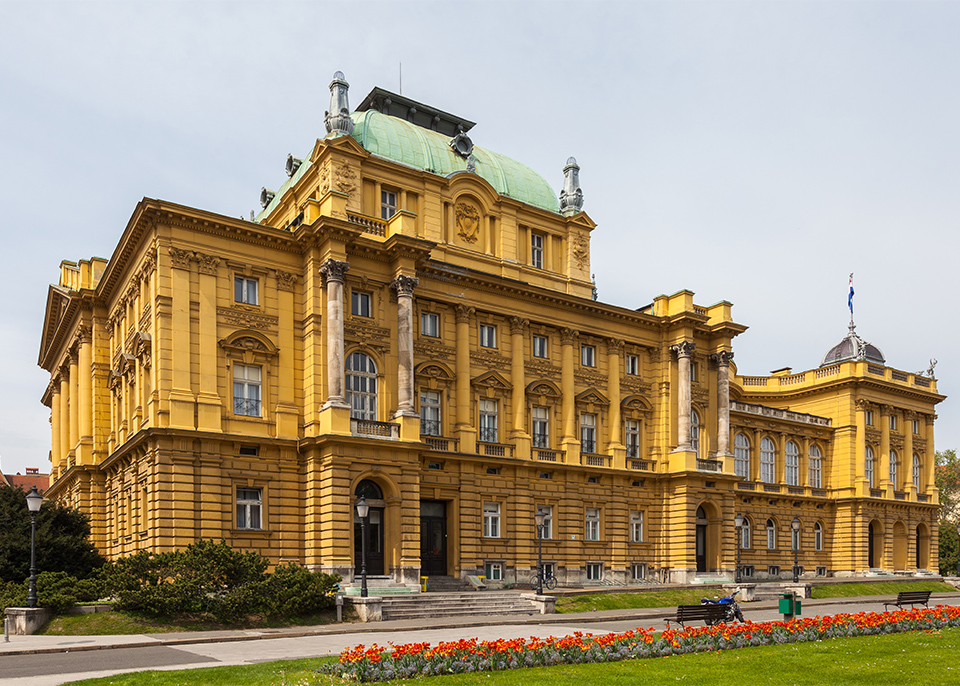
(Photo: Diego Delso, Teatro Nacional, Zagreb, Croacia, 2014-04-13, DD 02, cropped to 7:5, CC BY-SA 3.0)
But the National Theater is also a great place for a coffee break: The BisTAČ@HNK is known for excellent coffee and friendly service – on their terrace if the weather is nice. They are open daily from 8 a. m. to midnight, weekends till 2 a. m.
Practical Information
How to Get There
Plane
Zagreb’s Franjo Tuđman Airport is about 16 kilometers southeast of the city center.
Your best option to go to the city center will be by shuttle bus. Although the last bus is scheduled for 10.30 p. m. transport is organized for passengers who arrive later due to delayed flights, so don’t worry. The first bus from the city center leaves at 4:30 a.m. A single trip costs 6 €uros.
Since it’s only about 2.5 hours to Ljubljana, the Franjo Tuđman Airport is often a gateway to Slovenia, too.
Train
Of all the places I visited during my trip through Croatia, Zagreb has been the only one accessible by train. Further south, majestic mountain ranges make railway travel impossible.
However, if you are going for instance to Ljubljana or Vienna, train rides are definitely an option.
Zagreb’s main train station, the Glavni Kolodvor, is just ten minutes south of the city center.
Bus
As explained above, it’s impossible to travel to the Croatian coast by train. Therefore, long-distance buses are really big. There is a comprehensive route system, the coaches are clean and modern, and relatively cheap.
What I liked a lot about bus travel in Croatia were the terminals located right in the city centers or at least on the very outskirts instead of shady, sketchy ghetto-ish suburbs like in many other places. Also, the service is excellent: There is always the possibility to store your luggage for a while, there are bathrooms and sometimes even showers, and an adjacent snack bar where you can stock up on munchies for the trip.
The bus terminal in Zagreb is located about ten minutes by tram from the city center. It’s a huge building with various storeys.
At the terminal, you’ll find small kiosks and windows where you can obtain bus tickets. To buy my ticket to Porec, I had to pay cash. I don’t know if they’ve changed that by now, however, there are ATMs right at the terminal’s central hall, so there shouldn’t be a problem.
How to Get Around
If you’re not as much into walking as I am or if the weather is not hike-friendly, the tram is your best option. It’s a really good system that covers basically the whole city and tickets are fairly cheap. There is a price difference between buying tickets from a kiosk and from a driver. I’ve listed the current fares below.
| period of validity | kiosk | driver |
| 30 minutes | 0.53 €uros | 0.80 €uros |
| 60 minutes | 0.93 €uros | 1.33 €uros |
| 90 minutes | 1.33 €uros | 1.99 €uros |
| night | 1.99 €uros | 1.99 €uros |
There are also the following passes
| period of validity | fare | ||
| 1 day | 3.98 €uros | ||
| 3 days | 9.29 €uros | ||
| 7 days | 19.91 €uros | ||
| 15 days | 26.54 €uros | ||
| 30 days | 53.09 €uros |
However, if you get a Zagreb Card, public transport within the city is included.
The public transport company Zagrebački Električni Tramvaj, conveniently abbreviated to ZET, has a really neat and helpful website.
Where to Stay
In Croatia, it is very common to book yourself in a privately run Sobe – which is a room – or an Apartman – which is…you know it. Usually, both options come without breakfast, but with facilities so that you can prepare your own. Plus, there are bakeries all over the place selling not only plain bread but all kind of sweet and savory pastries. Obviously, there’s no need to worry, you won’t be starving.
On this map, you find some lodging options that will cater to all your needs*:
Booking.comBest Place to Eat
There are two dishes you absolutely have to try while in Zagreb.
The first one is Zagorski Štrukli, a dish that in 2007 made it on the list of Croatia’s intangible cultural heritage by Croatia’s Ministry of culture. So eating Štrukli, you’re basically on a cultural mission.
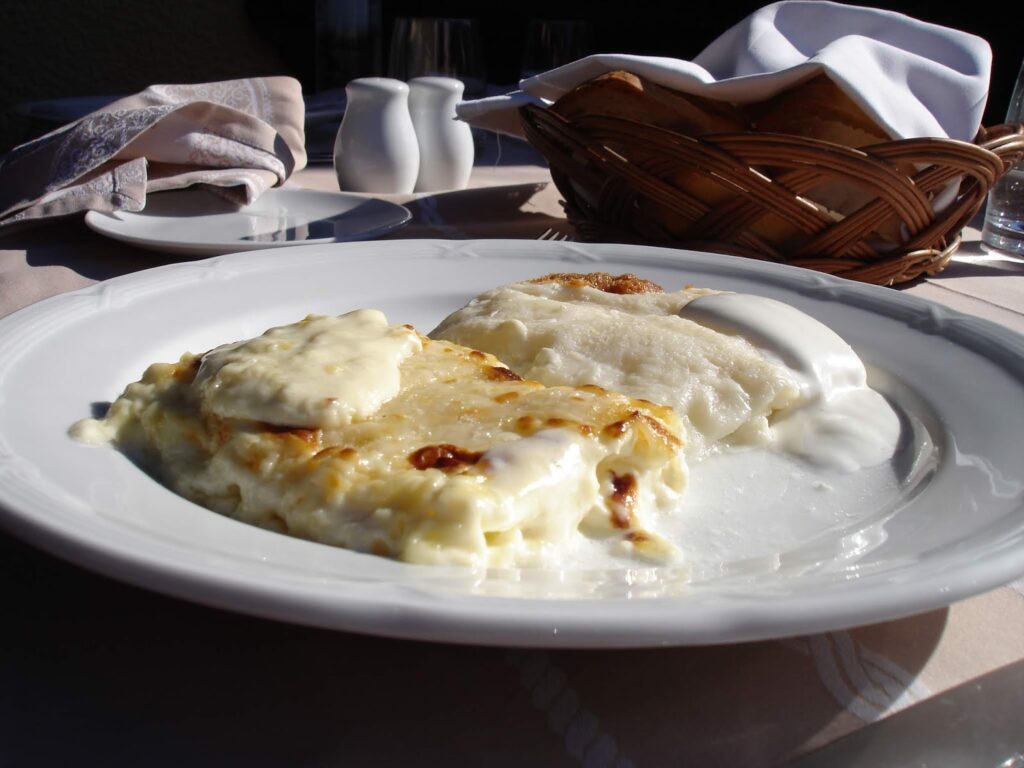
(Photo: Bonč, Štrukli iz Okrugljaka, CC BY-SA 3.0)
The best thing is that they come in sweet and savory versions, so everybody finds their piece of heaven.
No matter whom you ask for the best Štrukli, they will either take you to their grandma or recommend
La Štruk
Skalinska ul. 5
10000 Zagreb
Phone: + 385 – 1 – 4837 701
Open daily from 11 a. m. to 11 p. m. (Sunday to 10 p. m.)
The other dish is much less regional – actually, it’s a tradition in all of Croatia and even other Balkan countries: Ćevapi – preferably in a large flatbread, with fixings like Ajvar, Kajmak, and grilled pickled peppers.
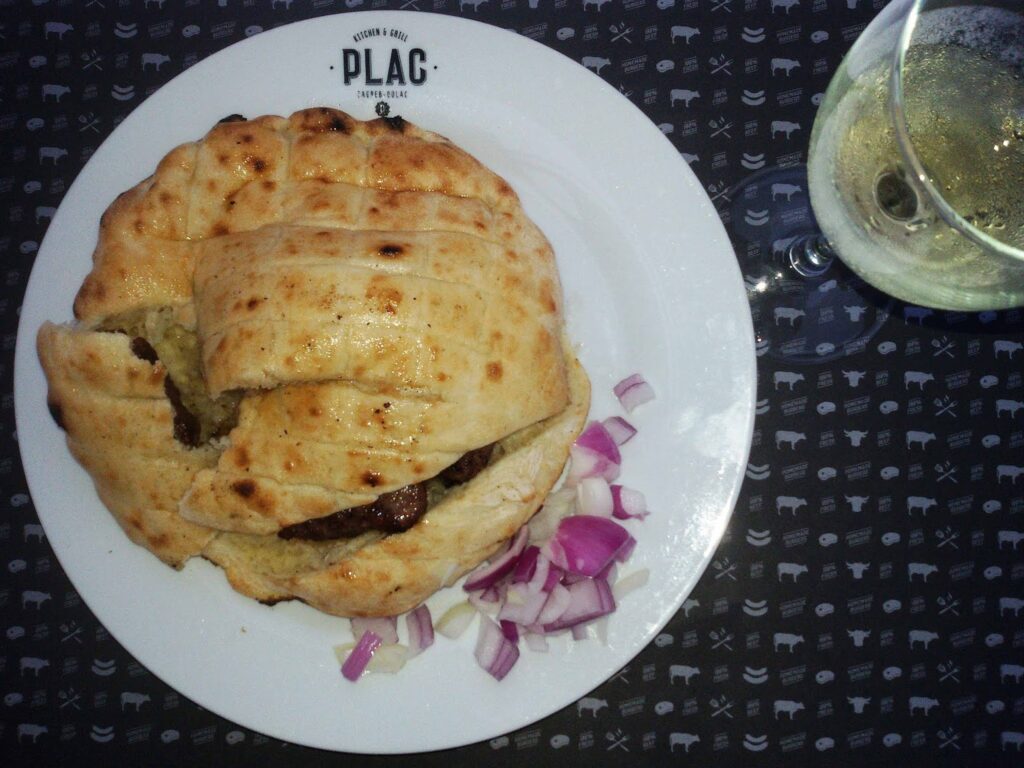
Right below the Dolac square are two great options to sample this delicacy – I find they are equally good:
Bistro Na Dolcu
Ul. Pod zidom 1A
10000 Zagreb
Phone: + 385 – 1 – 4827 758
PLAC Kitchen & Grill
Dolac 2
10000 Zagreb
Phone: + 385 – 1 – 4876 761
Cash And Cards
In 2022, Croatia replaced its currency Kuna with €uros. The exchange rate is 1 US$ = 0,94 EUR as of July 2023, but you can check the conversion on this page. Credit cards are widely accepted.
What to See
I’m an avid solo-travelling woman. Since solo travel doesn’t equal solitude, I love to join organized tours here and there. They allow me to meet fellow travellers – for just a short moment or a lifelong friendship.
Especially if you have only a short time for exploring Zagreb or want to explore some unbeaten paths, an organized trip will enable you to make the best of it*:
Do you need more detailed info on how to get to Zagreb and around in just one day? Then go to my post 24 hours in ZAGREB; you’ll find this one and many other great destinations in this blog’s 24 hours in…-section
Zagreb was only the first of many beautiful places I’ve visited in Croatia. To read about the others, go to the main post and take your pick! There you’ll also find valuable general information that will make your trip smoother.
Pinnable Pictures
If you choose to pin this post for later, please use one of these pictures:
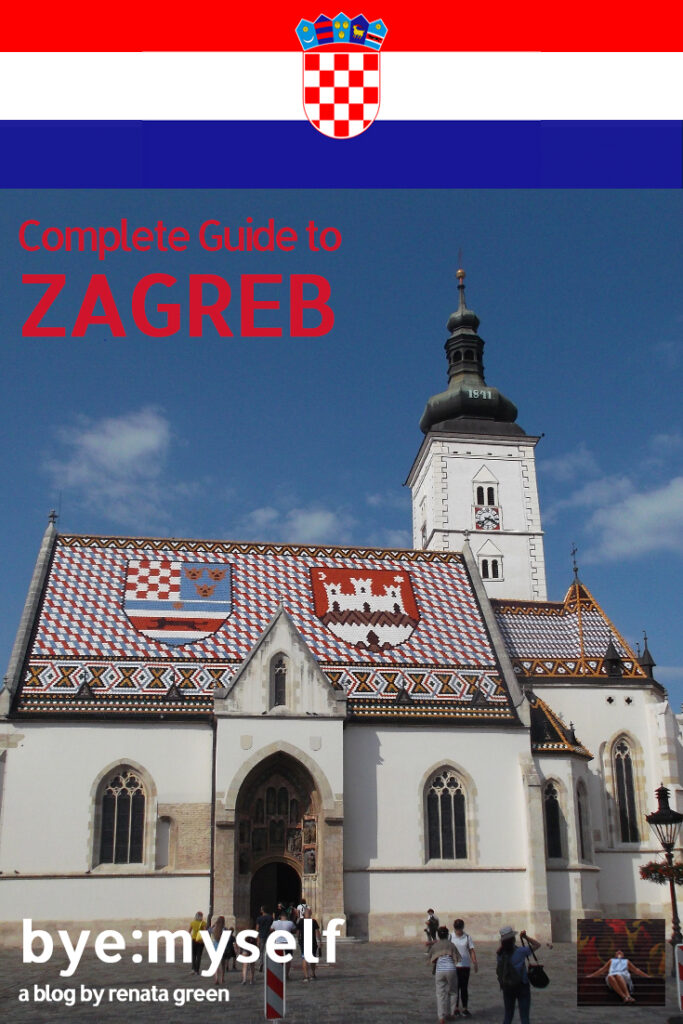
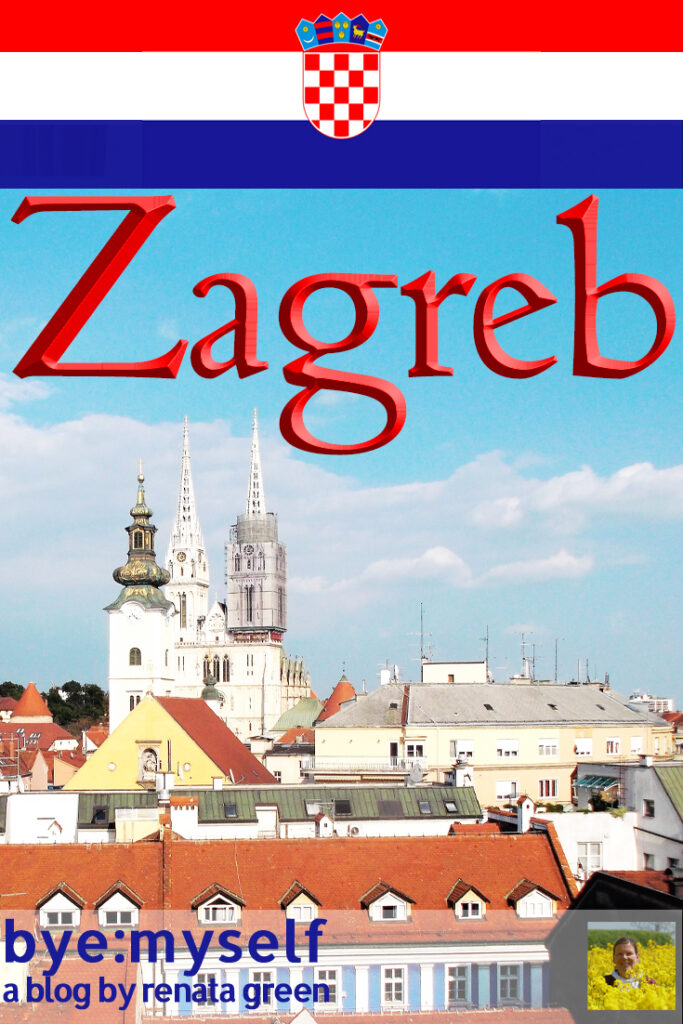

Note: I’m completing, editing, and updating this post regularly – last in July 2023.
Did You Enjoy This Post? Then You Might Like Also These:
Guide to SPLIT, a city that has it all
Guide to DUBROVNIK, the Lustrous Pearl of Dalmatia
Guide to KRKA National Park and SKRADIN
Pickled: Easy Recipes to Store the Mediterranean Sun in Your Pantry
Guide to PLITVICE LAKES: Waters in Dreamlike Colors
POREC – Venice’s Little Sister in Croatia
Guide to VELA LUKA on the Island of Korcula
CROATIA – Complete Guide to a Bus Road Trip
* This is an affiliate link. If you book through this page, not only do you get the best deal. I also get a small commission that helps me run this blog. Thank you so much for supporting me!

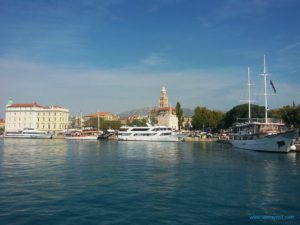
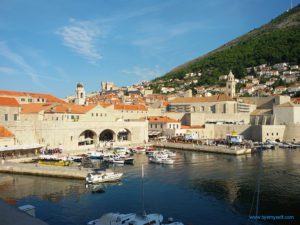
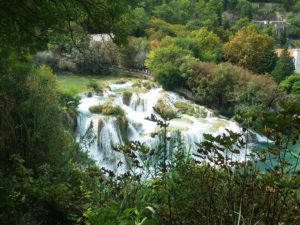

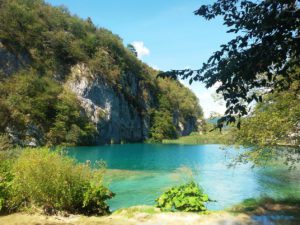
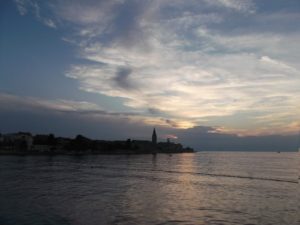
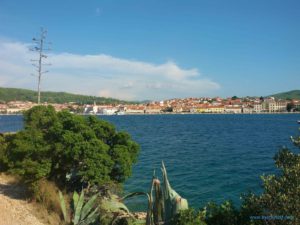
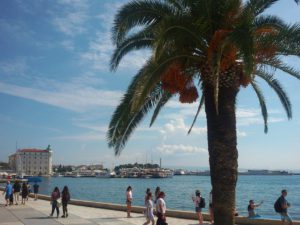
From its intriguing architecture to nearby natural havens – not to mention its coffee scene – this underrated European capital has something for everyone. This all-encompassing Zagreb guide provides proof.
Yes, Zagreb convinced me at the second glance 😉
As the inland capital of a country famous for its dazzling island-speckled coastline, Zagreb is often overlooked by travellers.
That’s true. I must admit that I visited because I didn’t fly but came by bus from Slovenia – the beauty of slow travel 😉
For those who aren’t so keen on coffee, there are other popular beverages on the Zagreb drinking scene. After sunset the city centre comes alive as the streets and squares transform into an open-air party. The epicentre of Zagreb nightlife is on Tkalciceva street, a buzzing, pedestrianised street lined with bar and restaurant terraces.
Wow, thanx for this valuable addition to my post – hvala! 🙂
Actually, Zagreb is one of the most visited places in Croatia, it's just not as known among tourists. It's a year round destination, compared to the most of the coast destinations that are very seasonal.